The Automotive Supercharger Market is estimated to be valued at USD 9.0 billion in 2025 and is projected to reach USD 14.5 billion by 2035, registering a compound annual growth rate (CAGR) of 4.9% over the forecast period.
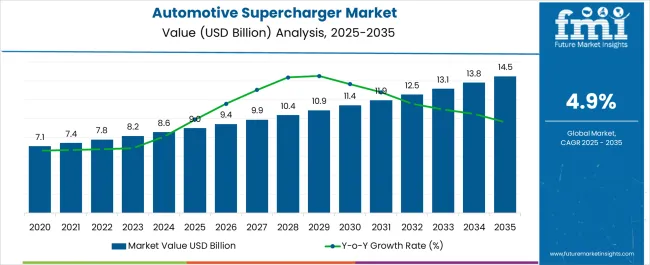
| Metric | Value |
|---|---|
| Automotive Supercharger Market Estimated Value in (2025 E) | USD 9.0 billion |
| Automotive Supercharger Market Forecast Value in (2035 F) | USD 14.5 billion |
| Forecast CAGR (2025 to 2035) | 4.9% |
The Automotive Supercharger market is experiencing significant growth, driven by the increasing demand for high-performance vehicles, rising consumer preference for fuel-efficient yet powerful engines, and tightening regulatory standards for emissions. Superchargers enhance engine performance by increasing air intake and combustion efficiency, allowing for improved acceleration and power output without significantly increasing engine size. Technological advancements, such as the development of lightweight materials, precision engineering, and integration with hybrid and electric powertrains, are further supporting adoption.
The growing focus on sustainable mobility solutions and performance optimization in passenger cars and commercial vehicles is shaping market dynamics. Automotive manufacturers are increasingly adopting supercharger technologies to meet performance expectations while complying with environmental regulations.
Rising investments in research and development, along with collaborations between OEMs and component suppliers, are accelerating innovation and production As consumer demand for high-performance, fuel-efficient vehicles continues to rise globally, the Automotive Supercharger market is expected to sustain robust growth over the coming decade, driven by technological advancements and increased adoption in both passenger and commercial vehicles.
The automotive supercharger market is segmented by product type, vehicle type, sales channel, and geographic regions. By product type, automotive supercharger market is divided into Centrifugal Superchargers and Positive Displacement Pumps. In terms of vehicle type, automotive supercharger market is classified into Passenger Car, Light Commercial Vehicle, and Heavy Commercial Vehicle. Based on sales channel, automotive supercharger market is segmented into Original Equipment Manufacturers (OEM) and Aftermarket. Regionally, the automotive supercharger industry is classified into North America, Latin America, Western Europe, Eastern Europe, Balkan & Baltic Countries, Russia & Belarus, Central Asia, East Asia, South Asia & Pacific, and the Middle East & Africa.
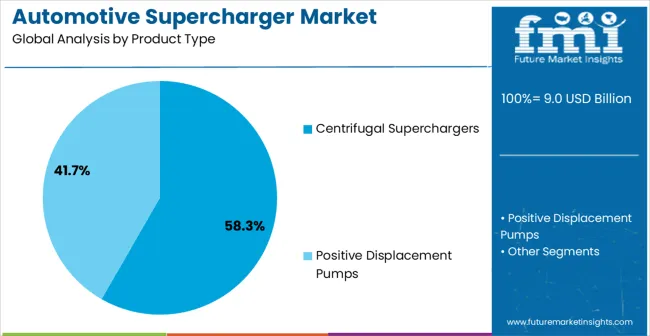
The centrifugal superchargers product type segment is projected to hold 58.3% of the market revenue in 2025, establishing it as the leading product type. Its market leadership is being driven by its high efficiency, compact design, and ability to deliver consistent power across varying engine speeds. These superchargers enable improved engine performance while maintaining fuel efficiency, making them particularly attractive for modern passenger cars and performance-oriented vehicles.
The integration of lightweight materials and precision-engineered components enhances durability and reduces operational noise. Adoption is further supported by advancements in turbocharging technologies that complement centrifugal superchargers, enabling optimized air compression and engine output.
Manufacturers favor centrifugal superchargers for their scalability and adaptability across a wide range of vehicle models, including hybrid platforms Continuous improvements in design and manufacturing processes, coupled with increasing consumer demand for high-performance yet efficient engines, are expected to sustain the leading position of centrifugal superchargers in the market.

The passenger car vehicle type segment is expected to account for 44.6% of the market revenue in 2025, making it the leading vehicle category. Growth is being driven by rising consumer preference for high-performance and fuel-efficient vehicles in urban and suburban regions. Superchargers provide enhanced acceleration, torque, and overall engine efficiency, which aligns with the demand for improved driving experience and performance standards.
Passenger car manufacturers are increasingly integrating superchargers in mid-size and luxury vehicles to meet both regulatory emission standards and consumer expectations for performance. Technological advancements in compact and lightweight supercharger systems facilitate seamless integration without affecting vehicle weight or fuel efficiency.
The growing popularity of hybrid and mild-hybrid passenger cars further supports adoption, as superchargers complement electric motor-assisted powertrains As automotive OEMs continue to focus on balancing efficiency, performance, and environmental compliance, the passenger car segment is expected to maintain its market leadership, driven by consumer demand and technological innovation.
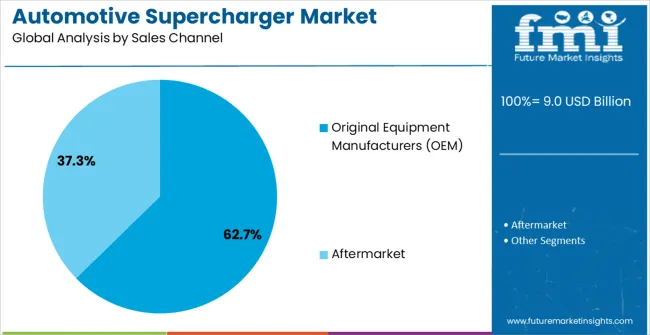
The original equipment manufacturers (OEM) sales channel segment is projected to hold 62.7% of the market revenue in 2025, establishing it as the leading distribution channel. Growth in this segment is being driven by the increasing preference for factory-fitted superchargers in new vehicles, ensuring performance optimization, reliability, and compliance with warranty and regulatory requirements. OEM-installed superchargers are integrated during vehicle production, allowing for precise calibration with engine management systems and minimizing compatibility issues.
Strong collaborations between automakers and component suppliers are facilitating technology transfer, innovation, and streamlined supply chains. OEM adoption is further encouraged by consumer trust in factory-installed performance enhancements and the assurance of certified quality standards.
As demand for high-performance, fuel-efficient vehicles continues to rise globally, the OEM channel remains the preferred route for supercharger distribution The segment’s leadership is reinforced by its ability to provide optimized vehicle performance, regulatory compliance, and reduced aftermarket dependency, supporting sustained market growth over the forecast period.
Shifting focus of manufacturers from turbochargers to superchargers utilizing more advanced technologies owing to meet increasingly stringent emission regulations, higher vehicle performance which could herald new era of downsized engines are anticipated to be the responsible factors for automotive supercharger market growth over the forecast period.
From the first actually tested engine supercharger in 1878 to first series produced cars Mercedes 6/25/40 hp and 10/40/65 hp in 1921, superchargers were used to increase the power output of an engine through allowing more fuel to be burned and more work per cycle. Power for the unit can be mechanically generated by a gear, belt, chain, or shaft connected to engine’s aircraft to enhance volumetric efficiency and to withstand higher forces.
Positive displacement and dynamic compressors are the two major type of superchargers in use by method of compression, where former delivering constant pressure increase at all engine speeds, while the latter delivers increasing pressure with increasing speed. Centrifugal superchargers being more efficient (70 – 85%) than positive displacement pumps are more in demand and popular.
Twin charging technique which is a combination of engine – driven supercharger and exhaust – driven turbocharger can mitigate the weaknesses of other techniques to increase power and efficiency of an engine. Increase in thermal load on engine parts and tendency to burn piston crown, edges, and seat of exhaust valves due to increased heat transfer and generation are some of the challenges faced by automotive superchargers.
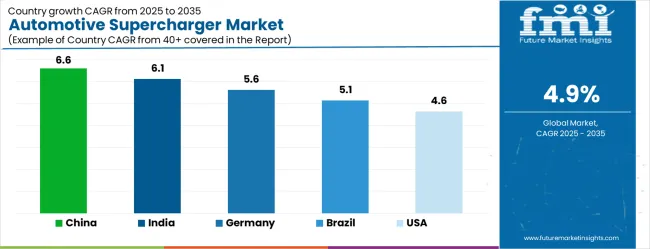
| Country | CAGR |
|---|---|
| China | 6.6% |
| India | 6.1% |
| Germany | 5.6% |
| Brazil | 5.1% |
| USA | 4.6% |
| UK | 4.2% |
| Japan | 3.7% |
The Automotive Supercharger Market is expected to register a CAGR of 4.9% during the forecast period, exhibiting varied country level momentum. China leads with the highest CAGR of 6.6%, followed by India at 6.1%. Developed markets such as Germany, France, and the UK continue to expand steadily, while the USA is likely to grow at consistent rates. Japan posts the lowest CAGR at 3.7%, yet still underscores a broadly positive trajectory for the global Automotive Supercharger Market. In 2024, Germany held a dominant revenue in the Western Europe market and is expected to grow with a CAGR of 5.6%. The USA Automotive Supercharger Market is estimated to be valued at USD 3.3 billion in 2025 and is anticipated to reach a valuation of USD 3.3 billion by 2035. Sales are projected to rise at a CAGR of 0.0% over the forecast period between 2025 and 2035. While Japan and South Korea markets are estimated to be valued at USD 484.7 million and USD 244.5 million respectively in 2025.
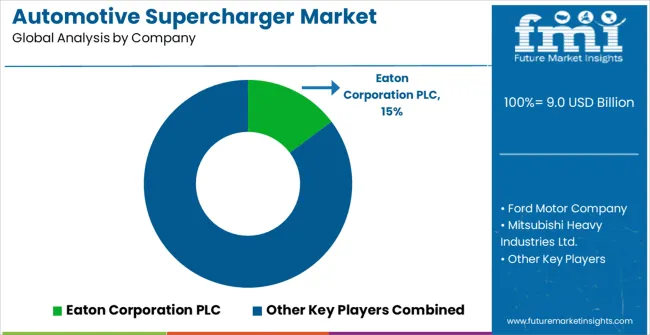
| Item | Value |
|---|---|
| Quantitative Units | USD 9.0 Billion |
| Product Type | Centrifugal Superchargers and Positive Displacement Pumps |
| Vehicle Type | Passenger Car, Light Commercial Vehicle, and Heavy Commercial Vehicle |
| Sales Channel | Original Equipment Manufacturers (OEM) and Aftermarket |
| Regions Covered | North America, Europe, Asia-Pacific, Latin America, Middle East & Africa |
| Country Covered | United States, Canada, Germany, France, United Kingdom, China, Japan, India, Brazil, South Africa |
| Key Companies Profiled | Eaton Corporation PLC, Ford Motor Company, Mitsubishi Heavy Industries Ltd., Honeywell Inc., Daimler AG, IHI Corporation, Ferarri N.V., Koenigsegg Automotive AB, Vortech Engineering, Federal-Mogul Corporation, Rotrex A/S, Aeristech, and A&A Corvette |
The global automotive supercharger market is estimated to be valued at USD 9.0 billion in 2025.
The market size for the automotive supercharger market is projected to reach USD 14.5 billion by 2035.
The automotive supercharger market is expected to grow at a 4.9% CAGR between 2025 and 2035.
The key product types in automotive supercharger market are centrifugal superchargers and positive displacement pumps.
In terms of vehicle type, passenger car segment to command 44.6% share in the automotive supercharger market in 2025.






Our Research Products

The "Full Research Suite" delivers actionable market intel, deep dives on markets or technologies, so clients act faster, cut risk, and unlock growth.

The Leaderboard benchmarks and ranks top vendors, classifying them as Established Leaders, Leading Challengers, or Disruptors & Challengers.

Locates where complements amplify value and substitutes erode it, forecasting net impact by horizon

We deliver granular, decision-grade intel: market sizing, 5-year forecasts, pricing, adoption, usage, revenue, and operational KPIs—plus competitor tracking, regulation, and value chains—across 60 countries broadly.

Spot the shifts before they hit your P&L. We track inflection points, adoption curves, pricing moves, and ecosystem plays to show where demand is heading, why it is changing, and what to do next across high-growth markets and disruptive tech

Real-time reads of user behavior. We track shifting priorities, perceptions of today’s and next-gen services, and provider experience, then pace how fast tech moves from trial to adoption, blending buyer, consumer, and channel inputs with social signals (#WhySwitch, #UX).

Partner with our analyst team to build a custom report designed around your business priorities. From analysing market trends to assessing competitors or crafting bespoke datasets, we tailor insights to your needs.
Supplier Intelligence
Discovery & Profiling
Capacity & Footprint
Performance & Risk
Compliance & Governance
Commercial Readiness
Who Supplies Whom
Scorecards & Shortlists
Playbooks & Docs
Category Intelligence
Definition & Scope
Demand & Use Cases
Cost Drivers
Market Structure
Supply Chain Map
Trade & Policy
Operating Norms
Deliverables
Buyer Intelligence
Account Basics
Spend & Scope
Procurement Model
Vendor Requirements
Terms & Policies
Entry Strategy
Pain Points & Triggers
Outputs
Pricing Analysis
Benchmarks
Trends
Should-Cost
Indexation
Landed Cost
Commercial Terms
Deliverables
Brand Analysis
Positioning & Value Prop
Share & Presence
Customer Evidence
Go-to-Market
Digital & Reputation
Compliance & Trust
KPIs & Gaps
Outputs
Full Research Suite comprises of:
Market outlook & trends analysis
Interviews & case studies
Strategic recommendations
Vendor profiles & capabilities analysis
5-year forecasts
8 regions and 60+ country-level data splits
Market segment data splits
12 months of continuous data updates
DELIVERED AS:
PDF EXCEL ONLINE
Automotive Direct Liquid Cooling IGBT Module Market Size and Share Forecast Outlook 2025 to 2035
Automotive Hoses and Assemblies Market Size and Share Forecast Outlook 2025 to 2035
Automotive Network Testing Market Size and Share Forecast Outlook 2025 to 2035
Automotive Performance Part Market Size and Share Forecast Outlook 2025 to 2035
Automotive Carbon Ceramic Brake Market Size and Share Forecast Outlook 2025 to 2035
Automotive Camshaft Market Size and Share Forecast Outlook 2025 to 2035
Automotive Stamping Industry Analysis in India Size and Share Forecast Outlook 2025 to 2035
Automotive Cylinder Liner Market Size and Share Forecast Outlook 2025 to 2035
Automotive Microcontroller Market Size and Share Forecast Outlook 2025 to 2035
Automotive Roof Rails Market Size and Share Forecast Outlook 2025 to 2035
Automotive Active Safety System Market Size and Share Forecast Outlook 2025 to 2035
Automotive Diagnostic Scan Tool Market Size and Share Forecast Outlook 2025 to 2035
Automotive Test Equipment Market Size and Share Forecast Outlook 2025 to 2035
Automotive Dynamic Map Data Market Size and Share Forecast Outlook 2025 to 2035
Automotive Green Tires Market Size and Share Forecast Outlook 2025 to 2035
Automotive E-Tailing Market Size and Share Forecast Outlook 2025 to 2035
Automotive Interior Market Forecast Outlook 2025 to 2035
Automotive Key Market Size and Share Forecast Outlook 2025 to 2035
Automotive Appearance Chemical Market Forecast and Outlook 2025 to 2035
Automotive Seating Market Forecast and Outlook 2025 to 2035

Thank you!
You will receive an email from our Business Development Manager. Please be sure to check your SPAM/JUNK folder too.
Chat With
MaRIA